The saree, one of the most iconic and versatile garments in Indian fashion, represents centuries of tradition, craftsmanship, and regional identity. Worn across India in countless ways, each region has its own unique style of draping a saree, reflecting cultural heritage and local influences. From the graceful pleats of Bengal to the regal drape of Maharashtra, saree draping has evolved to signify not just beauty, but the diversity of Indian culture.
In this blog, we’ll take a journey through the different saree draping styles from various regions of India, each carrying its own story and significance.
1. Nivi Style – Andhra Pradesh
The Nivi drape, originating from Andhra Pradesh, is the most widely recognized and popular saree style across India today. This style is elegant, practical, and universally flattering, which is why it’s worn by women across the country in daily life, formal events, and even on the runway.
- How it’s Draped: The saree is wrapped around the waist, and pleats are neatly tucked into the front. The pallu (the loose end) is then draped over the left shoulder. The pleats are aligned in front, creating a formal yet graceful look.
- Occasions: The Nivi drape is versatile and works for almost every occasion—be it casual wear, office attire, or festive functions.

2. Bengali Style – West Bengal
The fascinating manner of draping saree known as Bengali style drape is an age-old style and a regular feature in Indian films especially Bollywood and even in the Durga Puja festival. Its simplicity and sophisticat ion are ordered of draping style as they are to rich cultural back ground of Bengal s history
- How it’s Draped: To drape a Bengali saree, start by tucking the saree around your waist and bringing it around your body without making pleats. Pull the pallu over your left shoulder and bring it back around to the front of your right shoulder. Secure the pallu with a key ring or brooch for an authentic Bengali look.
- Occasions: Bengali drape has a certain ancient style and elegance with its vanity it incorporate disturbs during puja s like durga, weddings and other celebrations of people.
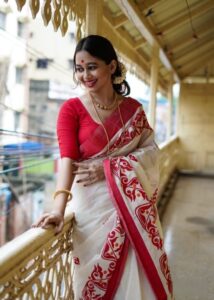
3. Maharashtrian Nauvari Style: Maharashtra
Nauvari saree drape has to be one of the most creative and distinct way of draping a saree in India. This style of draping the saree is also known as nauvari as in a nine yard draping. It is a style that sings of the shore bravery of the women from maharashta, who would often dress in this way back in the maratha empire.
- How it is Draped: Start by wrapping the saree around your waist and tucking it in, then pull the fabric between your legs and tuck it at the back like a dhoti. Drape the pallu over your shoulder or across your chest, securing it with pleats for a traditional Nauvari look.
- Occasions: This attire is frequently spotted during the traditional Maharashtrian festivals, weddings and cultural programs. It is also donned by women active participants in any religious or folk performance.
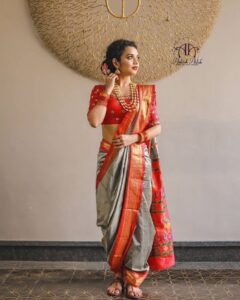
4. Gujarati Style – Gujarat
The main distinguishing feature of the Gujarati saree draping technique is the method of pallu and reverse pleats. Every saree draping style finds its roots in some part of the cultural history, and this one is no different as it even includes cultural aspects of Gujarat and Rajasthan, which naturally fits in those merry occasions like Navratri.
- How it’s Draped: In this manner the waist pleats a tucked at the back and the pallu is taken from behind the right shoulder across and towards the front over the chest. The pallu end usually is allowed to sag or pinned to the waist.
- Occasions: This is a common draping style for families particularly during Garba nights of Navratri, weddings and other functions of the culture.
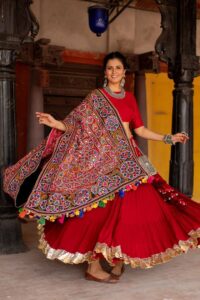
5. Kodagu Style – Karnataka
The Kodagu design (Coorg or Kodava saree) features a pattern exclusive to the Kodava people of the Indian state of Karnataka. This style is generally adopted by women commonly at traditional festivals and mass marriages.
- How it’s Draped: The pleats in this saree drape are formed in the posterior instead of the frontal aspect and the pallu is thrown on the shoulder and fixed in place. It is usually matches with ethnic ‘Coorgi’ styled ornamentation which adds to its beautification.
- Occasions: This style is majorly done during the marriages and the famous Puthari harvest festival in Coorg.
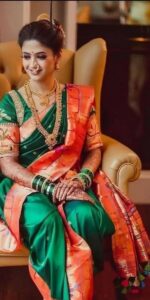
6. Mundum Neriyathum – Kerala
Mundum Neriyathum is the famous saree draping style of Kerala that dates backs centuries. It consists of two unstitched block fabrics, the bottom being worn is the mundu and the top drape is called neriyathu.
- How it’s Draped: The lower piece of saree (mundu) is firmly wrapped around the waist while the upper piece of saree (neriyathu) is draped over the left shoulder in a manner similar to that of pallu. The saree in this case is white or cream with strips of gold making it quite elegant but not overbling.
- Occasions: This style is very common during the Onam festival and other traditional events in the state of Kerala.
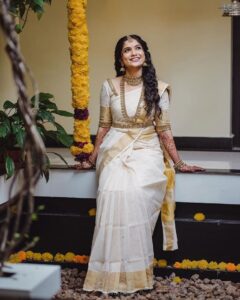
7. Assamese Mekhela Chador – Assam
Mekhela Chador is also an attire typical for Sāmi men and women of Sām. In Assam, a Mekhela Chador is worn instead of a saree which is the costume for the Assamese women. Not a saree in true sense, but it is something that is worn in a similar fashion.
- How it’s Draped: The Mekhela is a skirt worn below the waist, while the Chador is a piece of cloth that is worn above the waist over the left shoulder. The front of the chador has pleats that are folded down and tucked in.
- Occasions: The Mekhela Chador is commonly worn in Bihu, weddings, and Assamese cultural functions.
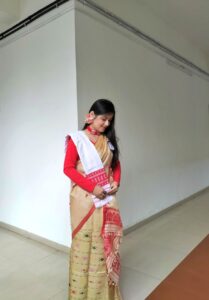
8. Tribal Styles – Jharkhand, Odisha, and Madhya Pradesh
In certain areas of Jharkhand, Odisha, and Madhya Pradesh, tribal women wear their sarees in a certain way that bonds them with nature and also symbolizes their simplicity. These differ from the traditional way of wearing lappets with heavy pleating and tying of the lappet at the back for carrying the luggages, as this lappet is usually tied onto the waist for easy movement during the daily chores.
- How it’s Draped: These drapings of a sari are quite a few but mostly come with simple draping styles with no much complicated pleats and often wrapped at the waist with the cover of the pallu above the breast.
- Occasions: These sarees are used on regular basis by the tribal women who in particular wear them during the harvest season and other community functions.
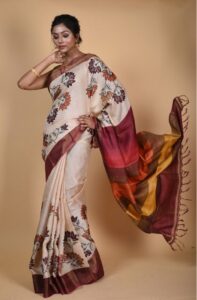
9. Madisaru – Tamil Nadu
Madisaru is a type of saree that is worn by Tamil Brahmin women for any religious or formal family function, especially weddings, and other such occasions. It is another ingenious nine yards draping style which is difficult to wear but carries immense traditional relevance
- How it’s Draped: The drape of Madisaru is rather elaborate where the sari is worn in a dhoti style with pleats tucked at the waist and the pallu thrown over one shoulder. Most of the time, this style is worn without a petticoat.
- Occasions: This is mainly donned on celebratory events such as weddings, public celebrations like Pongal and other religious gatherings.
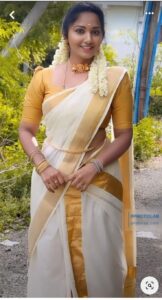
10. Konkan Style – Goa and Karnataka
The Konkan saree drape is an amalgamation of the South Indian Lady’s dress as well as the Maharashtrian style which is mostly found in the coastal areas of Goa and to some extent Karnataka.
- How it’s Draped: Like the Nauvari style, this too is a drape that has a dhoti look but here the fabrics used are lighter which makes it apt for the humid coastal climates. The left shoulder is often used to drape the pallu.
- Occasions: This is worn during the religious celebrations like Ganesh Chaturthi which honors the coast regions of India.
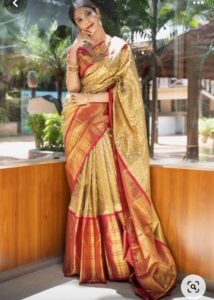
Conclusion
The saree is much more than just an article of clothing; it is a representation of our culture that stands for the vast range of people found in India. Each of the states in India has a distinct style of draping a saree which is influenced by the practices, beliefs and geographical settings of that particular region. From the grand Nauvari saree of Maharashtra, the classy Bengali setting to the otherworldly Mundum Neriyathum of Kerala, the styles of saree draping speak of the myriad tales of Indian heritage.
Accepting the different draping styles that are present today help the women of today to honor their heritage and the relevance of the saree dress. Be it a conventional drape or a fusion garment, a saree is an everlasting presentation of a woman’s beauty, grace and elegance.